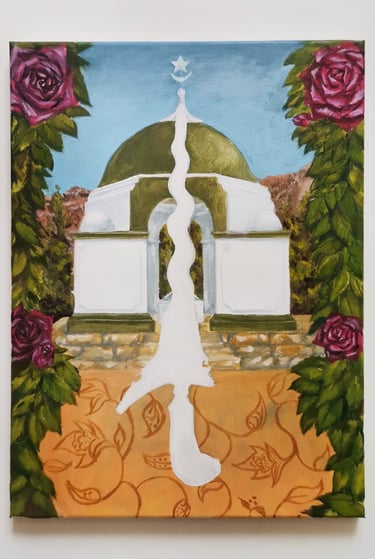PRESERVING CAPE HERITAGE AND CULTURE THROUGH EXPLORING VISUAL ARTS AND EDUCATION
The Kramats of Cape Town: A Heritage of Resistance
"Though their roles, in their struggle, in their homes came to an end in their banishment to the Cape, their arrival was the start of a heritage of resistance through their practice and proliferation of their faith and traditions."
THROUGH YOUR PEN
Whaleed Ahjum (Drake)
10/2/20245 min read


“It is said that approximately more than 250 years ago a prophecy was made that there would be a “Circle of Islam” around the Cape. According to local beliefs, the circle is complete by comprising the tombs of Auliyah (friends of Allah) who were brought as slaves to the Cape. South Africa is rich in Islamic culture and history and this heritage must be preserved for posterity. We owe these heroes and torchbearers of Islam and could never repay them for their sacrifices.”
(VidaMemoria and Cape Mazaars Society; Circle of Tombs (Kramats) Nomination 2019).
The Kramats, or mazaars, of the Cape are synonymous with the Cape Malay community. To those unfamiliar with the term, Kramats are the tombs of Muslim Saints, which encircle the Cape. The first which were laid to rest in what would become known as the “Circle of Saints”, were Orang Cayen, an honorific title afforded to men of wealth and influence. It was precisely for this influence which they had over the people of their lands of origin for which they found themselves flung to the furthest reaches of the empire of their invaders. People of noble heritage, leaders of resistance, were banished here for fear of serving as rallying points for uprisings and opposition to the colonial occupation of what is now Indonesia, Malaysia, Sri Lanka, India and other regions exploited for their resources and strategic locations.
Though their roles, in their struggle, in their homes came to an end in their banishment to the Cape, their arrival was the start of a heritage of resistance through their practice and proliferation of their faith and traditions.
Within the serene hills bounded by the forests of Constantia the tombs of two of the first notable exiles stand where they once would provide counsel, sermons and lead in prayer, the slaves of the Cape governor’s estate found spiritual guidance and upliftment in the figures of Sheikh Abdurahman Matebe Shah, and, Sayed Mahmoud [my own ancestor] whose kramat now stands atop Islam Hill in Constantia.
Before being brought to the Cape as a political prisoner in 1668, our ancestor Sayed Mahmoud was the Religious Advisor to the last true Sultan of the Malaccan Sultanate. He was Sayed, as his title suggests, which is to say a descendant from the Prophet Muhammad (SAW). This custom of assuming this title was adopted from the Ottoman Empire who at the time were the strongest of the Muslim empires. Malacca, however, was the richest in trade. So much so that Tome Pires, the Portuguese trader, is quoted as stating “Whoever is Lord of Malacca has his hand on the throat of Venice.” (Venice being the foremost trading post in the West at the time.)
Now the titles and position must not be mistaken for pomposity. For among other things which were adopted, was the Islamic principle that no matter a man’s station that he must still have a trade, as rizq (sustenance) must be earned by means of a trade. As with the Ottoman Sultans who assumed more refined or noble trades such as goldsmithing, hand-tooled leatherwork and woodwork with rare and precious woods to produce fine and often ornamental yet beautiful objects, yet it was still a trade and their practitioners were skilled and adept. When their people were taken prisoner and the regular population enslaved, these men exhibited astounding skill and integrity in the tasks they were set, albeit under duress. As we well know, the Cape Malays became well known for their craftsmanship and production before being superseded by industrial capitalism.
Though documents pertaining to their lives are precious few, with oral traditions providing most of what we know of them as documents of the first 50 years of the colony’s history pertains almost exclusively to matters concerning the Dutch East India Company and its interests. They brought with them not only their Islamic traditions, among which the equality amongst men regardless of race, class or ethnicity, the rights of women to possess wealth and property independently which in itself were ideas which threatened the order of the colonialists, but also the rich cultural traditions from their homelands. Many of which have not only fed into the traditions of the Cape Muslims but also contributed to the culinary traditions now seen distinctly South African.
It is significant to remember that their practice and spread of their faith was outlawed under the Statute of India [drafted by Van Dieman in 1642] which stated in one of its placaats [statutes]:
"No one shall trouble the Amboinese about their religion or annoy them; so long as they do not practice in public or venture to propagate it amongst Christians and heathens. Offenders to be punished with death, but should there be amongst them those who had been drawn to God to become Christians, they were not to be prevented from joining Christian churches. "
(The same Placaat was re-issued on August 23, 1657 by Governor John Maetsuycker)
The most notable of the Mazaars, in the collective memory of the community of the Cape, would have to be those of Sheikh Yusuf Al Makasari - his place of birth giving its name to the settlement which arose from the community that he founded just outside Stellenbosch; Makasar; and of course that of Abdullah ibn Qadi Abd ul-Salaam, or as he is better known Tuan Guru (“Sir Teacher”) to be found at on the base of Signal Hill at the Tanu Baru burial grounds. Prior to his banishment, Sheikh Yusuf led the last resistance against the combined force of the Dutch military supported by mercenaries and misled tribal factions in Goa. They made the last stand and having their fellow kinsmen turned against them to be instated as puppet rulers for the Dutch were eventually overpowered and exiled only to become known as the “Father of Islam” in the Cape. Though not entirely ill treated, he was afforded a retinue of 12 imams and servants to attend himself and his wives, he quickly gained a following and became a rallying point for the subjugated population of the enslaved.
Tuan Guru, who was responsible for, arguably, the first school to be established, after his banishment on Robben Island - where he penned not one but an additional four copies of the Holy Quran from memory. He conducted lessons and authored the oldest written example of the Afrikaans language in the Indonesian Jawi script; a variation for the arabic script in the form of kitaabs (books) on religious teaching instruction employed in his madressa (school) offering the opportunity for literacy which was denied to the enslaved and freeblack people of Cape Town.
But as the name of the collective mazaars have come to be known, the Circle of Saints (sometimes also referred to as the Circle of Islam) has great spiritual significance. In their lifetimes miraculous feats have been attributed to them and likewise their resting places have been attributed to be the sites of apparition and revelation. The tombs form a ring encircling the Cape Peninsula, which according to the oral tradition, protects the region from famine and calamity.
The 23 tombs are places of reverence, places of deep spirituality but also symbols of resistance and struggle. Symbols of a will which stood against the efforts of conversion and subjugation, to strive for self betterment, a tradition which has been passed on in the community as an ethos, which served a counter to intentions of the colonial empire then later the Apartheid regime.
They remain symbols of shared struggle and refusal to conform in the face of hardship.
Unlike the saints of the Christian tradition, one doesn’t visit the grave with the intention of requesting intercession, as in Islam, no such intermediary is required. Rather visitors are expected to observe a solemn, respectful conduct of themselves. Recitation of the Holy Qur’an, removal of one’s shoes and, if doing so, to converse in a low and respectful tone and manner within the enclosure.
Art by Whaleed Ahjum (Circle 1 series of 232024)


Featured image: Art by Whaleed Ahjum
Discover
Contact Us
Our cultural heritage matters
Help us learn and grow by sharing your respectful feedback on our website, exhibitions, social media and more:
Store's Terms and Conditions
